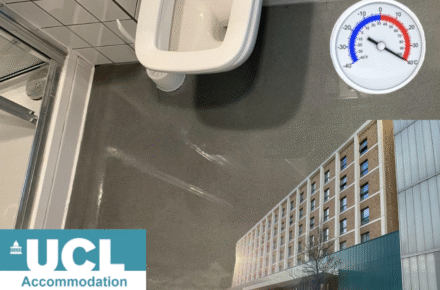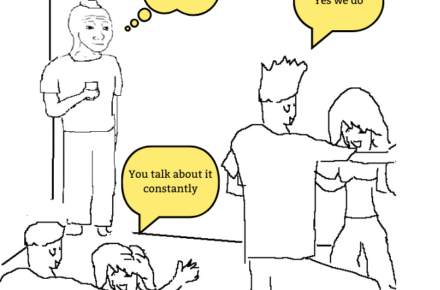I was fourteen when I first downloaded Depop. Back then, I could find a nice top or dress for £10 and get a good bargain for all the classic brands. Now, whenever I log onto the app, I see the most ridiculous stuff there – cargo pants with stains priced at £30 and children’s clothes rebranded as a size XS!
Depop was founded in 2011 to facilitate reselling of vintage, used or repurposed clothing. What drew me, and most users, to Depop, over its predecessor eBay, is its user-friendly interface modelled after Instagram. Sellers can post pictures of their items, along with descriptions, prices, hashtags; there exists a chat feature which allows negotiations and deals. Users can follow sellers and preferred categories to be able to see relevant posts on their personal feeds. Additionally, the Explore page features listings curated by the Depop’s staff. Although its founder, Simon Beckerman, envisioned it as a place for small business owners to kick off their sales, the social e-commerce platform’s biggest audience turned out to be regular individuals trading items straight from their closets.
As someone who is enthusiastic about thrift shopping, Depop has been one of my favourite platforms to shop from – no longer limited to the thrift stores in my immediate vicinity, I can browse for items across the country. Lately, however, certain dubious selling practises on it have made me reevaluate my frequent usage of the app.
Countless videos on Youtube and Tiktok dissecting the gentrification of thrift shopping and how Depop has supposedly contributed to it have been flooding my feeds for some time now. Similarly, “Depop drama” Instagram accounts, along with forums on Reddit, are popping up for users to publicly vent out their frustrations. I recently came across a Tiktok video featuring a creator complaining about how a blue argyle sweater vest was being sold for $50, when ‘it was probably thrifted for $2’. While I sympathised with the outraged buyer about the exorbitant price hike, I could also see why the seller would want to gain a profit off these pieces of clothing. Between unhappy buyers and frustrated sellers, Depop is fostering a community struggling with over-saturation and exploitation, which begs the question: how did it even get here?
I decided I would do my bit of online sleuthing, and after doom-scrolling on Instagram, Youtube and Tiktok (and swiping through the hellscape Reddit is), I’ve put together the bits and pieces of evidence I found to explain the relationship between gentrification and Depop, one that is more complicated than it seems.
The Buyers’ Dilemma
The general consensus amongst the buyers has been that the app is alienating its initial base of consumers by contributing to the gentrification of thrift stores through poor regulation of price hikes on second-hand items, drop-shipping and frequent scamming.
“Unreasonable markups’ is a common phrase in the sub-Reddit I regularly browse. Often, I notice buyers poking fun at the absurd listings they see – a toddler’s t-shirt rebranded as a ‘y2k baby tee’ listed for $35, or dresses from Reformation tagged “vintage”. It is important to highlight that garments can only be described as “vintage” if they are older than 20 years. Yet sellers falsely tag ‘vintage’ on clothing from fast-fashion brands such as Shein to gain traction on search feeds and hike prices. Surely, that 2016 Pretty Little Thing dress isn’t vintage yet!
Moreover, the issue of drop-shipping has been plaguing buyers for years now. Drop-shipping refers to a selling practice of purchasing whole-sale, on-trend products from third-party websites such as Ali Express or Amazon, and selling it at a tremendous markup for a profit. Mistaken for second-hand or hand-made items, cow-print jeans, avocado earrings and similar trendy products saturate the market. In reality, they are poorly made in unethical work environments and until March 2020, when Depop banned drop-shipping on its platform, buyers constantly got scammed into purchasing drop-shipped items for three times the original cost-price.
Put this way, it is easy to empathise with the buyers’ plight. Low-income individuals passionate about sustainability seem to be priced out of the second-hand clothing market, which was created for them in the first place. However, buyers rarely consider what it is like to be a seller on Depop.
The Sellers’ Plight
Youtuber and ex-Depop seller Alli Vera’s 28-minute-long video titled “Why I Quit Depop”, explains their perspective perfectly.
Vera described the process and the effort of being a reseller on Depop in detail. ‘It is very time consuming’, she says. ‘It’s not just looking at charity stores and picking up items to sell… I have to curate the items, clean them, mend them and take pictures of them to show them in the best light’. She goes on to say how the hike in price is also because ‘you are not just paying for the item. You are paying for my eye…my ability to look for it and make it accessible’. The returns aren’t always guaranteed either. Vera notes that ‘you don’t know when an item will sell or not. It’s always a risk knowing I might not make my money back on something’.
Interestingly, Vera’s account highlights that buyers are no longer just paying for the item, but also for the resources spent sourcing it, cleaning it and photographing it, which may explain the difference between original costs and selling prices.
Is it gentrification or simply inflation?
“It’s funny actually,” Vera remarks, ‘so many kids go on out here talking about how resellers are ‘stealing’ from low-income people. Literally such a majority of sellers are from low-income areas’. Yet, at the same time, by selling their curated items at a profit to boost their income and compensate for their efforts, successful low-income Depop users like Vera are taking the opportunity to buy cheap clothes from the original charity shops away from other individuals who wish to be environmentally conscious on a budget.
While both sides of the argument appear valid, upon diving into the origins of thrifting practises, I discovered that commercialisation of resale platforms is indeed contributing to the gentrification of thrifting. Thrifting was conceptualised as a common practice in the early 1900s after the founding of organisations such as Goodwill and Salvation Army. Originally targeted towards low-income groups due to their affordability, thrifting and similar sustainable practices have since been co-opted by younger generations as ‘trendy’ and subsequently commercialised into profitable businesses.
The internet accredits Depop’s success to the growing awareness of the evils of the fast-fashion industry. Presently, the fashion industry contributes to 10% of total carbon emissions, making it the second largest polluter in the world. This, along with accelerated trend cycles and overconsumption, has caused the shelf life of clothes to shorten. When what is no longer popular is either sent to the landfills or incinerated, thrifting presents itself as a better alternative: it closes the loop, gives clothes a new life and reduces waste.
Thus, while reselling thrifted clothes at hiked-up prices generates earnings for low-income sellers, it also creates economic barriers for low-income buyers. Because one of the main attractions of pre-used clothing has been its affordability, by driving up their prices, we are gatekeeping a sustainable practice. As gentrification, simply put, refers to the process of making something ‘refined’ or ‘respectable’, these economic barriers contribute to gentrifying practises of platforms like Depop by limiting affordability and accessibility to sustainability. What’s worse is that this may drive shoppers towards fast-fashion brands due to their inexpensive prices.
However, one user remarked on a Depop subreddit that there’s a lot of rage directed at individuals rather than institutions. It is easier to villainise people who can afford to visit multiple thrift stores and buy piles of items while ignoring the mechanism that makes this behaviour desirable.
Do something, Depop!
Vera’s video also discussed the lack of support from Depop itself. She states, “They used to encourage sales by covering shipping costs or reducing their fees. They don’t do that anymore”. Moreover, sellers are required to give a percentage of their earnings to Depop — “last year, I had to give them about $2000 in fees. Sure, it’s just 10%, but for someone who does this full time, it is a lot of money”.
Despite these apparent problems and growing animosity between buyers and sellers, Depop is doing better than ever. In the last year itself, the £4 billion company experienced a 200% rise in traffic and a 300% rise in sales. Still, to avoid alienating their large consumer base, Depop should evolve to encourage transparency and better regulate selling practises.
For buyers, Depop can improve their personalised algorithms and engage in further social responsibility by providing information on thrift-gentrification and conducting price inspections to ensure affordability and reasonable pricing. This could involve mandating that the original price of the item is included alongside the selling price. The company can support their sellers by re-introducing schemes such as ‘no-seller-fees’ or ‘no-shipping-costs’, and encourage small business owners and creative businesses over resellers.
Personally, I still believe that platforms like Depop are a great avenue for thrift-shopping – they’re quick, relatively cheap and encourage environmentally conscious practises. Yet, what started out as an inclusive and collaborative community has spiralled into a divisive and exclusionary one. While I agree that there is no ethical consumption under capitalism, Depop was, and can remain to be, a step in the right direction.
By Disha Takle
This article appeared in CG Issue 81









